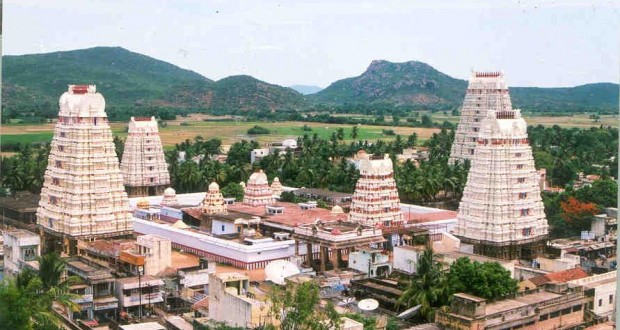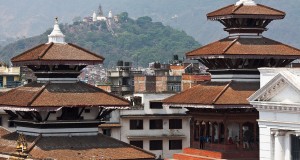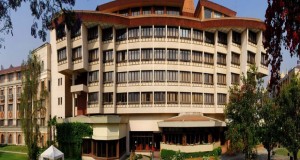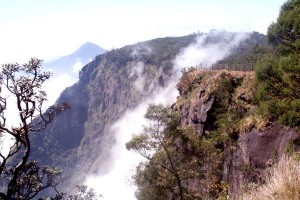 Bazaar, full of exotic stalls selling bright clothes, jewellery, incense, and spices. Enter the temple by the main gate, at the end of Town Hall Rd, and remember to deposit your shoes before entering. Just inside the entrance, bearing right, there’s usually a row of fortune-tellers.
Bazaar, full of exotic stalls selling bright clothes, jewellery, incense, and spices. Enter the temple by the main gate, at the end of Town Hall Rd, and remember to deposit your shoes before entering. Just inside the entrance, bearing right, there’s usually a row of fortune-tellers.
Just past these are a couple of ‘classrooms’ where, in the early evening, you can hear tuneful songs and prayers being practised. Turning left, you’ll find the South Tower. It used to be possible to climb to the top of this soaring gopuram, and to enjoy spectacular views over the whole temple complex. But then came a bomb scare, and the tower was temporarily closed to the public. It is worth asking if it is again open.Continuing anti-clockwise, you’ll come across the Golden Lily Tank, used by pious Hindus for sacred dips. The legend goes that any book thrown into it will sink if worthless (this guide is a rare exception). Surrounding the tank is a pillared portico, its walls decorated with paintings from Hindu mythology and verses from the Tamil classic, Tirrukkural.
Beyond the nearby mural of Meenakshi’s wedding to Shiva are the two singlestone sculptures of the temple’s 12th-century founder, and his chief minister. Behind the tank is the gate-facing shrine of Sri Meenakshi Sannath, guarded by two huge dwarabhalagas or doorkeepers. Past this, through the entrance gate of Sundareswarar Sannathi, you’ll find the beautiful hall of Kanibathadi Mandapam, notable for its excellent sculptures of Shiva. Next, wander over to the nearby Thousand Pillar Hall, which actually has only 985 superbly sculpted pillars. Two small temples stand on the space intended for the other 15 pillars. Much of the rest of the hall has been given over to the extensive Art Gallery—a fascinating, if poorly lit exhibition of Tamil temple art and architecture. Outside again, take directions for the Puthu Mandapam, opposite the Eastern Tower. Built by Thirumalai Nayak in honour of Sundareswarar, this is noted for its sculptures and for its imposing pillars, on which are carved representations of the four Nayak rulers. Just east of this is the Rajagopuram, a massive 53.5-m tower base which—had it been completed, would have been the tallest tower in south India.
Don’t feel obliged to follow this route to the letter, people often enjoy just wandering round Sri 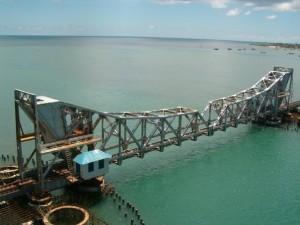 Meenakshi at random. The temple is open 5 am-12.30 pm, 4-10 pm daily, and the day to avoid is Friday, when hordes of pilgrims pour in. The most enjoyable time of day to visit is the early evening, when it’s relatively quiet and cool. There’s normally some musical entertainment going on (informal, inspired) at the Golden Tank from 6.15-7.30 pm, 9-10 pm. If you’re at the South Tower around 9.15 pm, you can see Shiva being ‘put to bed’. Photographs are only allowed inside the temple from 1-4 pm daily (camera fee Rs5). But you can pick up some good blackand- white prints in the bazaar, very cheaply.
Meenakshi at random. The temple is open 5 am-12.30 pm, 4-10 pm daily, and the day to avoid is Friday, when hordes of pilgrims pour in. The most enjoyable time of day to visit is the early evening, when it’s relatively quiet and cool. There’s normally some musical entertainment going on (informal, inspired) at the Golden Tank from 6.15-7.30 pm, 9-10 pm. If you’re at the South Tower around 9.15 pm, you can see Shiva being ‘put to bed’. Photographs are only allowed inside the temple from 1-4 pm daily (camera fee Rs5). But you can pick up some good blackand- white prints in the bazaar, very cheaply.
In the afternoon, take an auto-rickshaw (it’s complicated on foot) down to Thirumalai Nayak Palace. This palace, built by Thirumalai Nayak in 1636, fell into ruins and was partially restored by Lord Napier, Governor of Madras from 1866 to 1872. The original palace was four times larger than the existing building, though enough remains to make a visit worthwhile.
Enter via the magnificent granite portico into the rectangular courtyard, flanked by huge, tall colonnades. Walk up to the north-west of the building, to see the splendid Main Hall. Originally Thirumalai Nayak’s ‘bedroom’, it measures 41.5 m long by 20.9 m wide. It was also used as a theatre, where dancers, musicians and court magicians used to entertain the king and his guests. On the west side of the courtyard, visit the Celestial Pavilion (Swarg Vilasa). The large central dome is supported by 12 columns, but (a clever illusion) appears to lack any support whatsoever. The fine decorative stucco chunnam or shell-lime work on both the dome and its arches are a characteristic of Tamil ornamentation. The Celestial Pavilion is approached by a flight of steps guarded by a group of sculpted, damaged, mounted horsemen. The Palace is open 9 am-1 pm, 2-5 pm daily. There’s an excellent sound-and-light show in English here, commencing 6.30 pm daily. Tickets are Rs2 or Rs3. The cheaper tickets are best—you see far more.
Sights Round-up (by local bus, full day) Thirupparankundram-Mariamman Teppakulam Tank-Gandhi Museum- Government Museum From the PRC bus-stand, catch a No. 5 bus (they leave every 10 minutes) for the remarkable rock-cut temple of Thirupparankundram, 8 km (5 miles) out of town. This temple, carved into the side of a mountain, is one of the six sacred abodes of Subramanya, second son of Shiva, and celebrates his marriage to Deviyani, daughter of the rain god Indra. Opening times are 5 am-12.30 pm, 4-10 pm daily, and admission is free.
Entrance to the innermost shrine cut from solid rock is denied to non-Hindus, but there’s 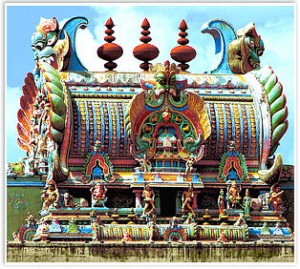 lots to see in the preceding series of mandapas or halls. These are generally packed to capacity with devotees preparing to go into worship. The head of each family distributes small lamp-lit bowls of coconut, fruit, rice and incense to his group, and marks their foreheads with the lines of Shiva in red or grey powder. You can follow them on their way into devotions, as far as the door leading to the inner chamber. Just beyond the door is a small courtyard, containing ‘Shiva’s Postbox’, where incinerated prayers drift up to the god through the soaring wicker-tower roof.
lots to see in the preceding series of mandapas or halls. These are generally packed to capacity with devotees preparing to go into worship. The head of each family distributes small lamp-lit bowls of coconut, fruit, rice and incense to his group, and marks their foreheads with the lines of Shiva in red or grey powder. You can follow them on their way into devotions, as far as the door leading to the inner chamber. Just beyond the door is a small courtyard, containing ‘Shiva’s Postbox’, where incinerated prayers drift up to the god through the soaring wicker-tower roof.
In the centre of the courtyard is a brightly-painted triumvirate of a Nandi (Shiva’s bull), a peacock and a rat fashioned of black granite. The surrounding pillars are surmounted by fierce stone lions, and the ceiling decorated with beautiful murals. Following the pilgrims out of the shrine, you’ll see them making offerings of boiled rice to the schools of leaping fish in the temple ghat. Out in the street again, sit awhile over a cup of chai and enjoy the colourful flow of people: pilgrims, priests, holy men and Indian families on their way to prayer.
Back at PRC bus-stand, catch bus No. 4 or hire a rickshaw to Mariamman Teppakulam Tank, 5 km (3 miles) east of the city. Measuring about 305 m square, this tank is almost as large as the Meenakshi Temple. Built by Thirumalai Nayak in 1646, it is the site of the big Float Festival held on the night of the January/February full moon. The central pavilion, Mayya Mandapam, houses a small temple and can be reached by boat, for a rupee or two. The tank is connected to the nearby Vaigai river by underground channels.
From here, take bus No. 6 to the Gandhi Museum (closed on Wednesday), 5 km (3 miles) north. It’s a 5-minute walk from the Collector’s Office in the new town. The museum contains various relics, photos and material relating to Mahatma Gandhi, a crafts exhibition of Khadi and Village industries, and a south Indian handicrafts display. Also here is a relatively new Government Museum (1981). Both museums are open daily 10 am-1 pm, 2-6 pm (the latter closed Fridays). To return to the old town, you’ll need a bus No. 3 or 4.
RECREATION
Lakshmi Sundaram Hall, Gokali Rd, Tallakulam (tel 25858), and Raja Sir Muthiah Mandram, opposite the district court, hold regular dance and music programmes. Near Gandhi Museum, there’s a yoga centre and a swimming-pool. Ladies’ hours are 2-4 pm.
SHOPPING
Madurai is a living bazaar—there are shops, stalls and markets everywhere. Cotton and silk clothing are the best buys, followed by cheap costume jewellery. There is no problem finding good clothes here. The streets are alive with salesmen carrying armloads of clothes and silver trinkets around, and they pester tourists with irresistible sales patter.
All the best tailors hang out opposite the East Tower of Meenakshi temple. Check out a guy called ‘Paramount’ in Shop 100—several travellers have found him of great help. Both here, and down by the South Gate, you can get clothes made up at very reasonable prices and in under 4 hours.
Poompuhar, the new government emporium opposite the rail station, has a good selection of fabrics, wood-carvings, stone-carvings, brass trays, and cotton lanterns at fixed prices.

